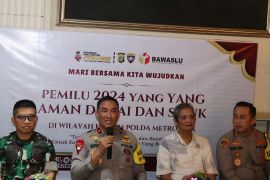Throughout the day, the villages are bursting with the sounds of music, vehicles, people talking, and even, people quarreling—and they can be heard even if windows and doors are shut firmly.
One such village is Kampung Rawa Village, Johar Baru Sub-district, Central Jakarta, which has a population density of 23,153 per 0.63 square kilometers (sq. km), or 91,079 per sq. km. And it lies just six kilometers away from the State Palace.
Given the high population, the region experiences frequent social problems, one of which is the difficult-to-resolve and frequent conflict between villages.
The roots of these problems lie in the overcrowding of the capital city, which has led to residential areas expanding to satellite cities surrounding Jakarta, such as Bogor, Depok, Tangerang, and Bekasi (Bodetabek), with the total metropolitan area known as Jabodetabek or Greater Jakarta.
The population spread should have been controlled earlier so as not to cause new problems. However, some issues have arisen, such as the emergence of slum areas in the Bodetabek region.
The uncontrolled distribution of population has also caused environmental problems, for instance, rivers and lakes in the region have shrunk and green open spaces have disappeared.
The need for spatial control and planning due to the convoluted spread of the population has also been felt in the Puncak and Cianjur (Punjur) areas of West Java.
In the west, the increasing population, in need of more residential areas, has spread to Tangerang district, Serang District, and Purwakarta to the east.
The government has anticipated the population spread by issuing Government Regulation No. 22 of 2020 on the Greater Jakarta Area Spatial Planning Coordination Team covering 189 sub-districts.
Under the plan, the Bodetabek regional governments are serving as regulators and preparing regulations that are being used as guidelines for the development of more organized housing complexes.
Better housing development has led to city-scale residential areas, or independent cities, which have sometimes exceeded the boundaries of regional administrations.
The presence of new planned cities in Bodetabek has made it easier for the region to manage spatial planning. This is because the new city developers are not only building houses but are also obliged to build infrastructure and provide commercial facilities.
These developing cities in Bodetabek are expected to help solve the issue of overcrowding in Jakarta, as they fulfill all the requirements of residents, including jobs.
Collaboration
The development of satellite cities can serve as a solution for reducing congestion in Jakarta. Not just the Indonesian capital, other major cities in the world also have satellite cities.
However, realizing ideal satellite cities is not easy as it requires collaboration among the central government, local governments, and the private sector as developers for synchronizing policies and minimizing potential conflict.
Director General of Housing at the Ministry of Public Works and Public Housing Khalawi Abdul Hamid said that the development of satellite cities, such as in the Tangerang District, is an urgent requirement to answer the need for decent housing for the community.
The private sector can play a significant role in the government's One Million Houses program by developing city-scale residential areas complete with supporting facilities, Hamid added.
Besides building houses, it can also help develop supporting ecosystems such as educational facilities, markets, health facilities, and offices so that residents do not need to travel far to obtain necessities.
It is possible to develop several segments of housing given the high availability of land near industrial areas and the government center area, both in Jakarta and Banten Provinces.
To support the large-scale housing development, the Tangerang district government must commit to issuing regulations on land allocation or land use according to the regional spatial planning (RTRW) and detailed spatial planning (RDTR) and the housing and settlement development plan (RP3KP), as well as a regulation requiring developers to release 50 percent of the total land needed.
Tangerang District Head A. Zaki Iskandar said that with a population of four million, the presence of decent housing is a must. Some areas in Tangerang are already developed, but some near the coastline need more support.
High interest
Regarding the presence of satellite cities in Tangerang district, the director of private developer company Paramount Land, M. Nawawi, confirmed that there is high public interest in city-scale housing areas because of affordable prices and the availability of facilities.
Based on data, almost 70 percent of the buyers are from the productive age group of 25 to 40 years whose previous domiciles were Greater Tangerang and West Jakarta.
According to him, the majority of buyers express their intention to buy housing because there is a certainty of handover, the land is free of disputes, and the environment is already thriving, in the sense that there are already residents, health facilities, education, and so on.
There are also other added values such as the availability of public transportation, small roads, arterial roads, and freeways for people living in satellite cities.
Satellite cities are also built to be connected to each other, with the aim of complementing the needs of the residents.
Furthermore, it is worth noting that the presence of residents makes satellite and independent cities liveable and helps expand the economic sector.
Collaboration is key for making regions support the development of Jakarta.
Related news: Driving transportation change in city where President lives
Related news: Greater Jakarta: Number of public transport users on the rise
Editor: Rahmad Nasution
Copyright © ANTARA 2022












